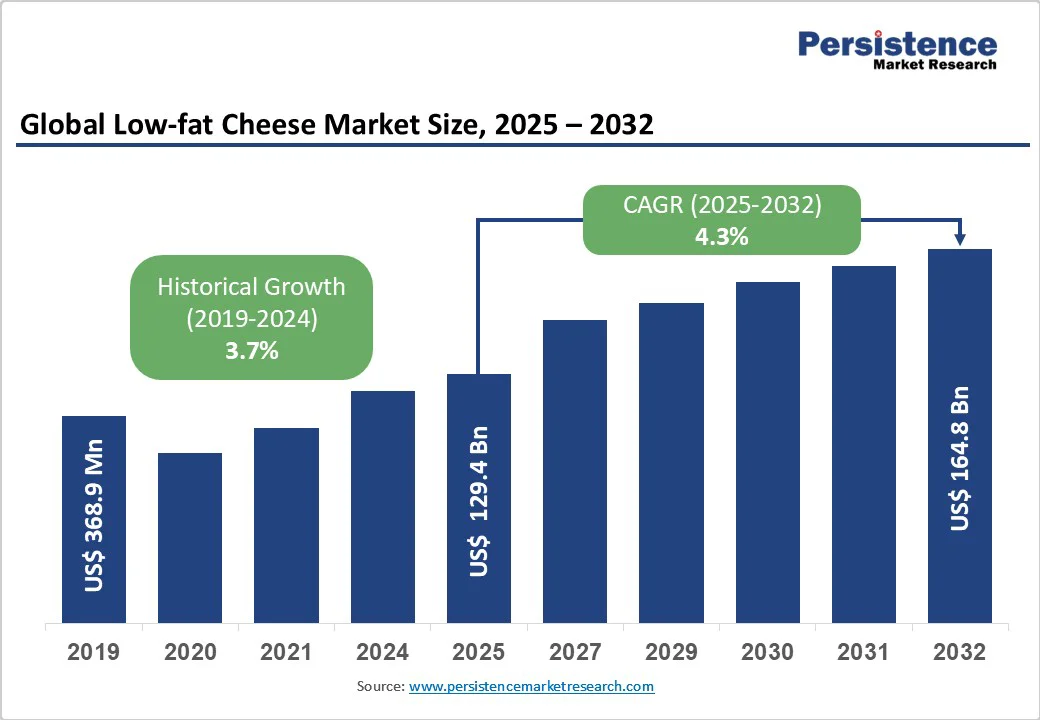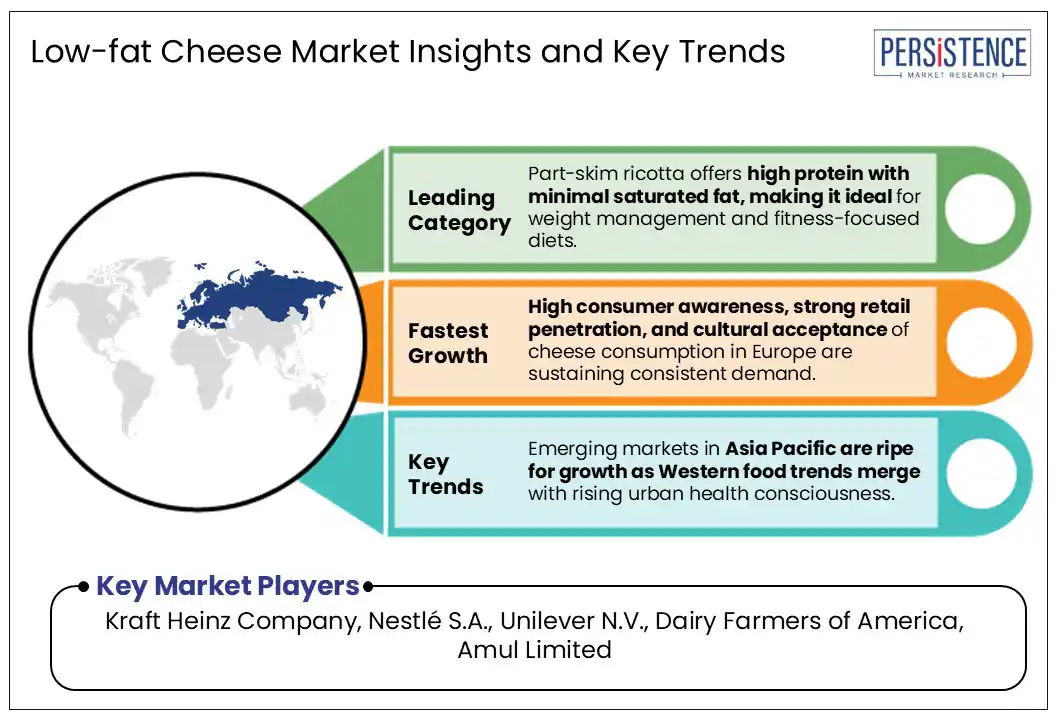ID: PMRREP35479| 196 Pages | 11 Jul 2025 | Format: PDF, Excel, PPT* | Food and Beverages

The global low-fat cheese market size is likely to be valued at US$ 129.4 Bn in 2025 and is expected to reach US$ 164.8 Bn in 2032, growing at a CAGR of 4.3% during the forecast period 2025-2032.
The global low-fat cheese market has transitioned from a niche segment to a prominent position within the mainstream dairy industry. Driven by a surge in health awareness and a growing demand for functional foods, low-fat cheese is increasingly favored by consumers seeking to reduce saturated fat intake while maintaining taste and culinary versatility. Advances in dairy technology and product innovation have significantly improved the texture and flavor profile of low-fat cheese, overcoming previous perceptions of inferior quality.
As concerns surrounding obesity, cardiovascular health, and nutritional transparency intensify worldwide, low-fat cheese is gaining widespread acceptance among health-conscious individuals, fitness enthusiasts, culinary professionals, and families. This shift is further propelled by evolving dietary preferences, regulatory support for healthier food options, and a strong focus on clean-label ingredients. The low-fat cheese market is poised for robust growth as manufacturers respond with innovative offerings that align with consumer expectations for both nutrition and taste.
Key Industry Highlights:
| Key Insights | Details |
|---|---|
|
Low-fat Cheese Market Size (2025E) |
US$ 129.4 Bn |
|
Market Value Forecast (2032F) |
US$ 164.8 Bn |
|
Projected Growth (CAGR 2025 to 2032) |
4.3% |
|
Historical Market Growth (CAGR 2019 to 2024) |
3.7% |

Rising concerns about childhood obesity are directly influencing parental buying behavior and school nutrition policies, pushing the low-fat cheese market growth. According to the World Obesity Atlas 2024, the number of children aged 5 to 19 living with obesity globally is projected to reach over 200 Mn by 2035. Significant spikes are likely to be observed in regions such as North America, Europe, and parts of Asia. In response, public health agencies and school authorities are actively revising dietary guidelines to limit saturated fat intake in meals served to children. This is further positioning low-fat cheese as a key substitute for traditional full-fat dairy.
A key example is from the U.S., where the USDA’s National School Lunch Program mandates strict fat and calorie thresholds for dairy products. It has resulted in a noticeable uptick in the procurement of cheese snacks such as low-fat mozzarella and cheddar slices for school cafeterias. A 2023 report from the School Nutrition Association highlighted that 78% of participating schools now include low-fat cheese in their weekly menus, mainly in sandwich kits, pasta dishes, and salads. The move is both a cost-effective and palatable way to meet dietary compliance while preserving taste appeal for children.
The potential for undesirable flavor development during aging is a significant barrier limiting the wide adoption of low-fat cheese. It is evident in categories such as cheddar, gouda, and parmesan that rely heavily on aging to develop complexity. Fat acts as a carrier for flavor compounds and supports microbial activity that bolsters enzymatic breakdown of proteins and lipids into flavorful peptides and fatty acids. In reduced-fat cheese, the absence of sufficient milk fat alters this biochemical balance, often leading to off-flavors such as bitterness, astringency, or a rubbery mouthfeel.
Research published in the Journal of Dairy Science revealed that low-fat cheddar aged for over six months developed noticeably stronger bitter peptides compared to full-fat versions. These peptides are the result of incomplete proteolysis due to altered microbial dynamics, as the fat-reduced matrix affects how bacteria interact with the cheese during ripening. Consumers often associate these flavors with spoilage or poor quality, creating a negative perception that discourages repeat purchases.
Effective marketing campaigns that focus on the dual appeal of nutrition and taste are significantly expanding the reach of low-fat cheese, especially non-dairy cheese. Brands such as Eatlean in the U.K. and Horizon Organic in the U.S. have launched targeted campaigns that emphasize not just reduced fat content but also high protein density, calcium levels, and clean-label ingredients. Eatlean’s digital campaign, for example, showed side-by-side comparisons with full-fat cheddar, highlighting that its product contains 90% less fat and 45% more protein.
Social media and influencer-led promotions are further playing a key role in spreading these messages. In Australia, Woolworths partnered with fitness influencers to promote their house-brand Light Ricotta as a post-workout protein snack. It has led to a 19% spike in sales over 10 weeks, as per internal retail data from 2024. These campaigns often include recipe-based content such as low-fat cheese powder, smoothies, high-protein pasta, or keto-friendly wraps. This makes the product more relatable and integrated into daily diets rather than perceived as a restrictive health substitute.
By product type, the market is segregated into feta, ricotta, mozzarella sticks, and hard cheese. Out of these, ricotta is anticipated to account for around 35.1% of the low-fat cheese market share in 2025 due to its naturally low-fat content and versatility across both savory and sweet applications. Unlike aged cheeses that require high fat content for flavor development, ricotta is made from whey, typically containing only 4 to 10% fat, depending on the variety. This makes it inherently leaner than cheeses such as cheddar or brie, even without special fat-reduction processing.
Mozzarella sticks have gained impetus owing to their convenience, portion control, and adaptability to reduced-fat formulations without significant compromise in taste or texture. Low-moisture, part-skim mozzarella is inherently lower in fat than many other cheese types, primarily containing around 6 grams of fat per 28g stick, compared to 9 to 10 grams in full-fat cheddar sticks. This makes it convenient for manufacturers to offer a product that fits within nutritional guidelines without requiring heavy modification or artificial additives.
Based on distribution channel, the low-fat cheese market is divided into foodservice, hypermarkets/supermarkets, online, and convenience stores. Among these, hypermarkets/supermarkets are estimated to hold nearly 32.6% of the share in 2025, with their ability to combine a wide product assortment, competitive pricing, and refrigeration infrastructure in one accessible location. These retail formats offer consumers immediate access to a diverse range of low-fat cheese variants. These allow the side-by-side comparison of brands, promotional offers, and nutritional labels.
Online has become a significant distribution channel, backed by its ability to cater to niche dietary requirements, with product transparency, and deliver directly to consumers who look for convenience. The increasing demand for specialty low-fat and functional dairy products, which are often not stocked in traditional brick-and-mortar stores, is another key driver. E-commerce platforms such as Amazon Fresh, Ocado, and BigBasket have responded by expanding their refrigerated delivery capabilities. This enables small brands to reach a wide, health-conscious consumer base without limitation on retail shelf space.

North America’s market is rapidly evolving due to the intersection of health trends and premiumization. The U.S. low-fat cheese market is predicted to dominate as consumers are seeking protein-rich, low-fat options without compromising on taste or texture. It is leading to a surge in reformulated cheese offerings. As per the U.S. Department of Agriculture (USDA), per capita cheese consumption in the country reached a record 42.4 pounds in 2023. A noticeable portion of this growth stems from healthy variants such as low-fat mozzarella and cheddar.
Leading brands such as Sargento and Kraft have introduced new SKUs catering to calorie-conscious consumers, such as Sargento’s Balanced Breaks Reduced Fat range. It includes low-fat cheese paired with nuts and dried fruits. Regional and artisanal brands are further experimenting with natural aging and fermentation methods to produce low-fat cheese without added stabilizers. Plant-based companies, including Follow Your Heart, are also entering the segment with low-fat vegan cheese alternatives, tapping into the flexitarian trend.
In 2025, Europe is expected to account for approximately 35.4% of the share due to deep culinary traditions and emerging health-conscious eating habits. It is also supported by government initiatives that advocate reduced saturated fat intake and strong retail penetration in supermarkets and hypermarkets. In Western Europe, classic varieties such as mozzarella, feta, cottage, and Neufchâtel cheese are sold in reduced-fat formats rather than entirely reimagined products. This helps brands in preserving their traditional appeal while addressing nutritional concerns.
Germany is at the forefront owing to public health campaigns and revamped labeling aimed at steering consumers toward low-fat products. On-the-go formats, including snack-sized mozzarella sticks, are gaining momentum in the U.K. as urban lifestyles flourish. Quark, Skyr, cottage, and Parmigiano-Reggiano cheese also witness high popularity as staple low-fat protein sources across regions such as Scandinavia and Central Europe. Domestic producers are focusing on clean-label, enzyme-enhanced processes and fat mimetics to improve taste and texture while maintaining nutritional gains.
In Asia Pacific, concerns about obesity, diabetes, and heart disease are pushing consumers toward nutrient-dense, low-saturated-fat foods, including protein-rich cheeses. Australia will likely dominate in terms of ricotta and mozzarella stick sales as consumers favor convenient, on-the-go low-fat cheese snacks. The proliferation of supermarkets, hypermarkets, and e-commerce across the country is also predicted to increase the production of low-fat cheese.
Japan is taking a unique route by focusing on fermented low-fat cheese products that cater to both gut health and reduced calorie intake. This reflects a broad trend toward functional foods in the country. In China, manufacturers are starting to diversify portfolios with low-fat alternatives, especially for export and premium retail segments. Similarly, in India, there is a booming market for reduced-fat paneer and chhena, conventionally high-fat fresh cheeses, now being re-engineered for calorie-conscious consumers without compromising cultural relevance.
The global low-fat cheese market is characterized by several established dairy giants and emerging health-focused brands. Leading players are leveraging their broad distribution networks and brand equity to cater to the increasing demand for healthy dairy alternatives. They often reformulate existing products to reduce fat content while preserving taste, using proprietary processing techniques and enzyme modifications. Small-scale companies are gaining traction by offering organic, clean-label, or plant-based low-fat cheese variants, targeting consumers seeking transparency and functional nutrition.
The low-fat cheese market is projected to reach US$ 129.4 Bn in 2025.
Rising parental focus on childhood obesity and high demand for low-calorie snacks are the key market drivers.
The low-fat cheese market is poised to witness a CAGR of 4.3% from 2025 to 2032.
Technological developments in culture manipulation and the emergence of diet-specific low-fat cheese products are the key market opportunities.
Kraft Heinz Company, Nestlé S.A., and Unilever N.V. are a few key market players.
|
Report Attribute |
Details |
|
Historical Data/Actuals |
2019 - 2024 |
|
Forecast Period |
2025 - 2032 |
|
Market Analysis Units |
Value: US$ Bn/Mn, Volume: As Applicable |
|
Geographical Coverage |
|
|
Segmental Coverage |
|
|
Competitive Analysis |
|
|
Report Highlights |
|
|
Customization and Pricing |
Available upon request |
By Product Type
By Application
By Distribution Channel
By Region
Delivery Timelines
For more information on this report and its delivery timelines please get in touch with our sales team.
About Author